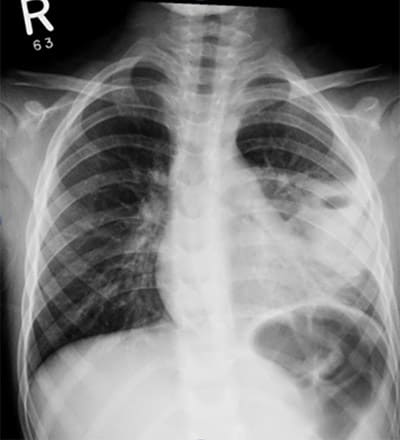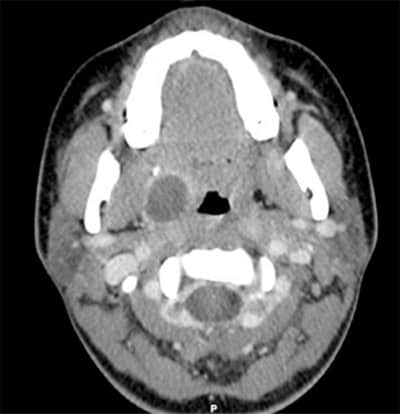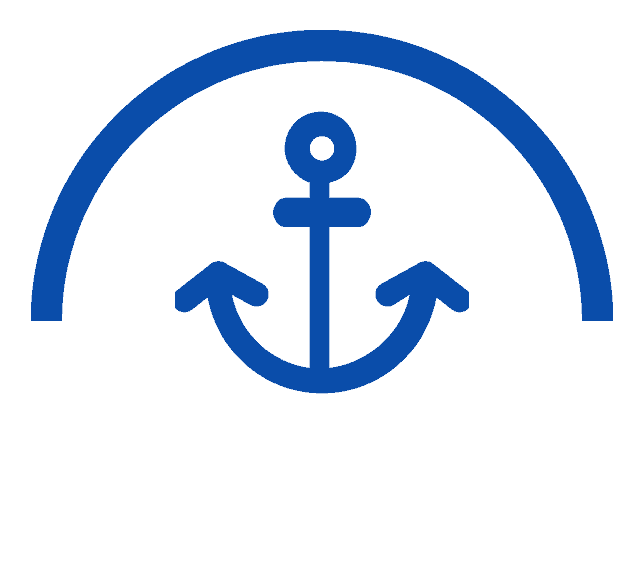TRY THESE SAQ’s
A 38 year old injecting drug user presents complaining of dyspnoea and lassitude. He also has left sided neck pain.
His vital signs are: HR 110 /min
BP 90/45 mmHg
RR 28 /min
Sats 99% RA
Temp 39.6 oC
(a) What specific features will you enquire about on history to assess this man’s airway? (3 marks)
(b) A routine chest xray is performed, and is shown. What does it show? (2 marks)
(c) The patient has a CT of the neck performed, and an image is shown. Give 2 major abnormalities, and the likely diagnosis. (3 marks)
(d) Give 2 actions you will take to manage this patient.(2 marks)

Answer
What specific features will you enquire about on history to assess this man’s airway?
Must include:
– voice changes
– ability to swallow own secretions
– presence of any obstructed flow noise (stridor/wheeze)(b) (2 marks)
A routine chest xray is performed, and is shown below. What does it show?
Must include:
– left lower lobe consolidation
– air fluid level suggestive of lung abscess(c) (3 marks)
The patient has a CT of the neck performed, and an image is shown below.
Give 2 major abnormalities, and the likely diagnosis.
Must include:
– large thrombus in R internal jugular vein
– significant soft tissue oedema distorting normal airway anatomy
Diagnosis:
– septic thrombophlebitis of the internal jugular vein (Lemierre’s syndrome)(d) (2 marks)
Give 2 actions you will take to manage this patient.
Must include:
– administration of broad spectrum antibiotics – piperacillin/tazobactam 4.5g
– urgent referral to a head and neck surgeon
A 28 year old male presents to your department after being run over by a motorcycle whilst participating in motocross. The motorcycle ran directly over the patient’s abdomen, and he has tyre marks and a large bruise in the left hypochondrium.
The patient’s initial vital signs are:
HR 105 /min
BP 104/68 mmHg
RR 19 /min
Sats 99% RA
T 36.8 oC
(a) The junior surgical registrar who has attended your trauma call asks you to perform a FAST scan “to exclude abdominal injury”. What is the role of FAST scanning in this patient?(3 marks)
(b) A CT scan of the patient’s abdomen is shown. What abnormalities does it show? (2 marks)
(c) The patient’s blood pressure drops on return from CT to 65/-, and the HR increases to 120/min. The patient has already had 2 units of packed red cells in the CT scanning room. There are no other injuries discovered on the CT scan. (3 marks)
(d) What are your haemodynamic endpoints for these treatments? (2 marks)

Answer
Answer must include (1 mark each themes)
– FAST is a specific test, not a sensitive one.
– It is used for compartment triage in haemodynamically unstable patients (ie to prioritize laparotomy without CT scan)
– This patient is stable, and therefore a FAST scan will not alter the need for a CT scan, or give additional information to this.(b) A CT scan of the patient’s abdomen is shown below. What abnormalities does it show? (2 marks)
Must include:
– rupture of the left kidney
– large retroperitoneal haematoma(c) The patient’s blood pressure drops on return from CT to 65/-, and the HR increases to 120/min. The patient has already had 2 units of packed red cells in the CT scanning room. There are no other injuries discovered on the CT scan. (3 marks)
What treatments will you administer to this patient in view of this problem (4 marks)?
Must include:
Massive transfusion protocol in ratio of 1:1:1. :
– Packed red cells
– FFP and platelets
– Cyroprecipitate
Adjuncts:
– Tranexamic acid 1g
– Or Calcium to ensure N ionised serum Ca++(d) What are your haemodynamic endpoints for these treatments? ( 2 marks)
A 50 year old woman presents after a domestic altercation. Her partner has stabbed her in the left side of the neck with a kitchen knife.
(a) What are the anatomic boundaries of the zones of the neck? (3 marks)
(b) The stab wound is anterior to the left sternocleidomastoid muscle and above the cricoid cartilage. What are the major vascular structures at risk here? (1 mark)
(c) Give 4 features on examination would indicate injury to one of these two structures. (2 marks)
(d) What are the underlying principles of the “no zone” approach to neck trauma? (4 marks)
Answer
Must include:
Zone 1: clavicle/suprasternal notch to cricoid cartilage.
Zone 2: Cricoid cartilage to angle of mandible.
Zone 3: Angle of mandible to the base of the skull.(b) The stab wound is anterior to the left sternocleidomastoid muscle and above the cricoid cartilage. What are the major vascular structures at risk here? (1 mark)
Must include carotid artery and internal jugular vein (this is zone 2 of the neck).(c) Give 4 features on examination would indicate injury to one of these two structures. (2 marks)
Must include: (0.5 marks)
– active haemorrhage
Plus any from: (0.5 marks each maximum 1.5 marks)
– systemic hypotension
– thrill
– bruit
– pulse deficit
– contralateral hemiparesis
– large haematoma/neck swelling
– tracheal deviation away from side stabbed(d) What are the underlying principles of the “no zone” approach to neck trauma? (4 marks)
Must include (themes, 1 mark each)
– poor correlation between external site of injury and structures injured
– CT angiography of the neck gives clear delineation of injuries in stable patients
– unstable patients must go to OT irrespective of where the injury is.
– the above therefore make algorithms based on the anatomic zone of the neck irrelevant.
See Shiroff AM, Gale SC, Martin ND et al. Am Surg 2013 79(1):23-9 for a great overview, or Low GM, Inaba K et al. Am Surg 2014 80(10): 970 – 4.










